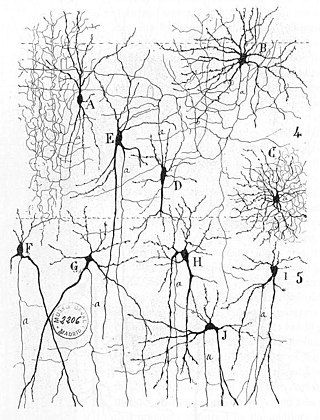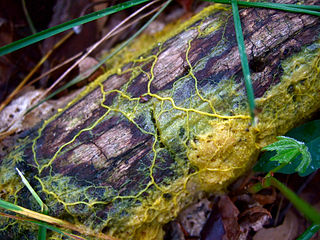Related Research Articles

Slime mold or slime mould is an informal name given to several kinds of unrelated eukaryotic organisms with a life cycle that includes a free-living single-celled stage and the formation of spores. Spores are often produced in macroscopic multicellular or multinucleate fruiting bodies which may be formed through aggregation or fusion. Slime molds were formerly classified as fungi but are no longer considered part of that kingdom. Although not forming a single monophyletic clade, they are grouped within the paraphyletic group Protista.
Computer science is the study of the theoretical foundations of information and computation and their implementation and application in computer systems. One well known subject classification system for computer science is the ACM Computing Classification System devised by the Association for Computing Machinery.

DNA computing is an emerging branch of unconventional computing which uses DNA, biochemistry, and molecular biology hardware, instead of the traditional electronic computing. Research and development in this area concerns theory, experiments, and applications of DNA computing. Although the field originally started with the demonstration of a computing application by Len Adleman in 1994, it has now been expanded to several other avenues such as the development of storage technologies, nanoscale imaging modalities, synthetic controllers and reaction networks, etc.

Theoretical computer science (TCS) is a subset of general computer science and mathematics that focuses on mathematical aspects of computer science such as the theory of computation, lambda calculus, and type theory.
Bio-inspired computing, short for biologically inspired computing, is a field of study which seeks to solve computer science problems using models of biology. It relates to connectionism, social behavior, and emergence. Within computer science, bio-inspired computing relates to artificial intelligence and machine learning. Bio-inspired computing is a major subset of natural computation.
Neuromorphic computing is an approach to computing that is inspired by the structure and function of the human brain. A neuromorphic computer/chip is any device that uses physical artificial neurons to do computations. In recent times, the term neuromorphic has been used to describe analog, digital, mixed-mode analog/digital VLSI, and software systems that implement models of neural systems. The implementation of neuromorphic computing on the hardware level can be realized by oxide-based memristors, spintronic memories, threshold switches, transistors, among others. Training software-based neuromorphic systems of spiking neural networks can be achieved using error backpropagation, e.g., using Python based frameworks such as snnTorch, or using canonical learning rules from the biological learning literature, e.g., using BindsNet.
The expression computational intelligence (CI) usually refers to the ability of a computer to learn a specific task from data or experimental observation. Even though it is commonly considered a synonym of soft computing, there is still no commonly accepted definition of computational intelligence.

A neural network can refer to either a neural circuit of biological neurons, or a network of artificial neurons or nodes in the case of an artificial neural network. Artificial neural networks are used for solving artificial intelligence (AI) problems; they model connections of biological neurons as weights between nodes. A positive weight reflects an excitatory connection, while negative values mean inhibitory connections. All inputs are modified by a weight and summed. This activity is referred to as a linear combination. Finally, an activation function controls the amplitude of the output. For example, an acceptable range of output is usually between 0 and 1, or it could be −1 and 1.

A wetware computer is an organic computer composed of organic material "wetware" such as "living" neurons. Wetware computers composed of neurons are different than conventional computers because they use biological materials, and offer the possibility of substantially more energy-efficient computing. While a wetware computer is still largely conceptual, there has been limited success with construction and prototyping, which has acted as a proof of the concept's realistic application to computing in the future. The most notable prototypes have stemmed from the research completed by biological engineer William Ditto during his time at the Georgia Institute of Technology. His work constructing a simple neurocomputer capable of basic addition from leech neurons in 1999 was a significant discovery for the concept. This research acted as a primary example driving interest in the creation of these artificially constructed, but still organic brains.
Rahul Sarpeshkar is the Thomas E. Kurtz Professor and a professor of engineering, professor of physics, professor of microbiology & immunology, and professor of molecular and systems biology at Dartmouth. Sarpeshkar, whose interdisciplinary work is in bioengineering, electrical engineering, quantum physics, and biophysics, is the inaugural chair of the William H. Neukom cluster of computational science, which focuses on analog, quantum, and biological computation. The clusters, designed by faculty from across the institution to address major global challenges, are part of President Philip Hanlon's vision for strengthening academic excellence at Dartmouth. Prior to Dartmouth, Sarpeshkar was a tenured professor at the Massachusetts Institute of Technology and led the Analog Circuits and Biological Systems Group. He is now also a visiting scientist at MIT's Research Laboratory of Electronics.
Neuroinformatics is the field that combines informatics and neuroscience. Neuroinformatics is related with neuroscience data and information processing by artificial neural networks. There are three main directions where neuroinformatics has to be applied:
Microbial intelligence is the intelligence shown by microorganisms. The concept encompasses complex adaptive behavior shown by single cells, and altruistic or cooperative behavior in populations of like or unlike cells mediated by chemical signalling that induces physiological or behavioral changes in cells and influences colony structures.
Unconventional computing is computing by any of a wide range of new or unusual methods. It is also known as alternative computing.

Physarum polycephalum, an acellular slime mold or myxomycete popularly known as "the blob", is a protist with diverse cellular forms and broad geographic distribution. The “acellular” moniker derives from the plasmodial stage of the life cycle: the plasmodium is a bright yellow macroscopic multinucleate coenocyte shaped in a network of interlaced tubes. This stage of the life cycle, along with its preference for damp shady habitats, likely contributed to the original mischaracterization of the organism as a fungus. P. polycephalum is used as a model organism for research into motility, cellular differentiation, chemotaxis, cellular compatibility, and the cell cycle.
Biological computers use biologically derived molecules — such as DNA and/or proteins — to perform digital or real computations.
Natural computing, also called natural computation, is a terminology introduced to encompass three classes of methods: 1) those that take inspiration from nature for the development of novel problem-solving techniques; 2) those that are based on the use of computers to synthesize natural phenomena; and 3) those that employ natural materials to compute. The main fields of research that compose these three branches are artificial neural networks, evolutionary algorithms, swarm intelligence, artificial immune systems, fractal geometry, artificial life, DNA computing, and quantum computing, among others.
The Computation and Neural Systems (CNS) program was established at the California Institute of Technology in 1986 with the goal of training Ph.D. students interested in exploring the relationship between the structure of neuron-like circuits/networks and the computations performed in such systems, whether natural or synthetic. The program was designed to foster the exchange of ideas and collaboration among engineers, neuroscientists, and theoreticians.
Andrew Adamatzky is a British computer scientist, who is a Director of the Unconventional Computing Laboratory and Professor in Unconventional Computing at the Department of Computer Science and Creative Technology, University of the West of England, Bristol, United Kingdom.

This glossary of artificial intelligence is a list of definitions of terms and concepts relevant to the study of artificial intelligence, its sub-disciplines, and related fields. Related glossaries include Glossary of computer science, Glossary of robotics, and Glossary of machine vision.
References
- ↑ Mitchell M (2010-09-21). "Biological Computation". Computer Science Faculty Publications and Presentations.
- ↑ Didales, K. (2006) Living Computers - Intelligent Plastic Machines.
- ↑ Didales K (2007). "Being - Our New Understanding of the Meaning of Life".
- ↑ Bray D (2009). Wetware: a computer in every living cell . New Haven: Yale University Press. ISBN 978-0-300-14173-3.
- ↑ Mitchell M (2010). "Biological Computation" (PDF). Archived from the original (PDF) on 2013-10-23.
- ↑ "Information and entropy in biological systems". NIMBios Workshop. 2015.
- ↑ Dean C (2019). "How Plants Recognise Seasons Using Molecular Memory". The Royal Institution.
- ↑ Lamm E, Unger R (2011). Biological Computation. Chapman and Hall/CRC.
- ↑ Biological Computation Group at MIT - Psrg.csail.mit.edu "Biological Computation Group at MIT". Archived from the original on 2013-10-30. Retrieved 2013-10-23.
- ↑ Regot S, Macia J, Conde N, Furukawa K, Kjellén J, Peeters T, et al. (January 2011). "Distributed biological computation with multicellular engineered networks". Nature. 469 (7329): 207–11. Bibcode:2011Natur.469..207R. doi:10.1038/nature09679. PMID 21150900. S2CID 4389216.
- ↑ "Biological Computation". Microsoft Research.
- ↑ Chu D, Prokopenko M, Ray JC (2018-12-06). "Computation by natural systems". Interface Focus. 8 (6): 20180058. doi:10.1098/rsfs.2018.0058. PMC 6227810 .
- ↑ "Computing with slime: Logical circuits built using living slime molds". ScienceDaily. Retrieved 2019-12-06.
- ↑ Adamatzky A, Akl S, Alonso-Sanz R, Van Dessel W, Ibrahim Z, Ilachinski A, et al. (2013-06-01). "Are motorways rational from slime mould's point of view?". International Journal of Parallel, Emergent and Distributed Systems. 28 (3): 230–248. arXiv: 1203.2851 . doi:10.1080/17445760.2012.685884. ISSN 1744-5760. S2CID 15534238.
- ↑ "Slime Mold Can Solve Exponentially Complicated Problems in Linear Time | Biology, Computer Science | Sci-News.com". Breaking Science News | Sci-News.com. Retrieved 2019-12-06.
- ↑ Adamatzky A (December 2018). "Towards fungal computer". Interface Focus. 8 (6): 20180029. doi:10.1098/rsfs.2018.0029. PMC 6227805 . PMID 30443330.